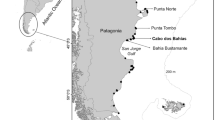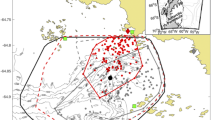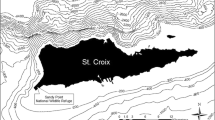Abstract
In the heterogeneous marine environment, predators can increase foraging success by targeting physical oceanographic features, which often aggregate prey. For northern fur seals (Callorhinus ursinus), two prevalent oceanographic features characterize foraging areas during summer in the Bering Sea: a stable thermocline and a subsurface “cold pool”. The objective of this study was to examine the influence of these features on foraging behavior by equipping fur seals from St. Paul Island (Alaska, USA) with time-depth recorders that also measured water temperature. Foraging bout variables (e.g., mean dive depth and percent time diving in a bout) were compared with respect to subsurface thermal characteristics (thermocline presence and strength and cold pool presence). Over 74% of bouts occurred in association with strong thermoclines (temperature change > 5°C). Few differences were found for dive behavior in relation to the presence of a thermocline and the cold pool, but for epipelagic bouts, a strong thermocline resulted in increased bottom times, number of dive wiggles, and percent time diving when compared to moderate thermoclines. There was also a positive relationship between mean dive depth and thermocline depth. The combination of increasing foraging effort in areas with strong thermoclines and diving to depths closely related to the thermocline indicates this feature is important foraging habitat for northern fur seals and may act to concentrate prey and increase foraging success. By recognizing the environmental features northern fur seals use to find prey, managers will be better equipped to identify and protect foraging habitat that is important to northern fur seals, and possibly other marine predators in the Bering Sea.





Similar content being viewed by others
References
Austin D, Bowen WD, McMillan JI, Boness DJ (2006) Stomach temperature telemetry reveals temporal patterns of foraging success in a free-ranging marine mammal. J Anim Ecol 75:408–420
Bailey KM (1989) Interaction between the vertical distribution of juvenile walleye pollock Theragra chalcogramma in the eastern Bering Sea, and cannibalism. Mar Ecol Prog Ser 53:205–213
Baker JD, Donohue MJ (1999) Ontogeny of swimming and diving in northern fur seal (Callorhinus ursinus) pups. Can J Zool 78:100–109
Baylis AMM, Page B, Goldsworthy SD (2008) Effects of seasonal changes in upwelling activity on the foraging locations of a wide-ranging central-place forager, the New Zealand fur seal. Can J Zool 86:774–789
Biuw M, Boehme L, Guinet C, Hindell M, Costa D, Charrassin JB, Roquet F, Bailleul F, Meredith M, Thorpe S, Tremblay Y, McDonald B, Park YH, Rintoul SR, Bindoff N, Goebel M, Crocker D, Lovell P, Nicholson J, Monks F, Fedak MA (2007) Variations in behavior and condition of a Southern Ocean top predator in relation to in situ oceanographic conditions. Proc Nat Acad Sci USA 104:13705–13710
Bodkin JL, Esslinger GG, Monson DH (2004) Foraging depths of sea otters and implications to coastal marine communities. Mar Mammal Sci 20:305–321
Bost CA, Handrich Y, Butler PJ, Fahlman A, Halsey LG, Woakes AJ, Ropert-Coudert Y (2007) Changes in dive profiles as an indicator of feeding success in king and Adélie penguins. Deep Sea Res II 54:248–255
Bost CA, Cotté C, Bailleul F, Cherel Y, Charrassin JB, Guinet C, Ainley DG, Weimerskirch H (2009) The importance of oceanographic fronts to marine birds and mammals of the southern oceans. J Mar Sys 78:363–376
Boyd IL, Arnould JPY, Barton T, Croxall JP (1994) Foraging behavior of Antarctic fur seals during periods of contrasting prey abundance. J Anim Ecol 63:703–713
Bradshaw CJA, Higgins J, Michael KJ, Wotherspoon SJ, Hindell MA (2004) At-sea distribution of female southern elephant seals relative to variation in ocean surface properties. ICES J Mar Sci 61:1014–1027
Burnham KP, Anderson DR (2002) Model selection and multimodel inference: a practical information-theoretic approach. Springer, New York
Byrd GV, Sydeman WJ, Renner HM, Minobe S (2008) Responses of piscivorous seabirds at the Pribilof Islands to ocean climate. Deep Sea Res II 55:1856–1867
Call KA, Ream RR, Johnson D, Sterling JT, Towell RG (2008) Foraging route tactics and site fidelity of adult female northern fur seal (Callorhinus ursinus) around the Pribilof Islands. Deep Sea Res II 55:1883–1896
Cartamil D, Wegner NC, Aalbers S, Sepulveda CA, Baquero A, Graham JB (2010) Diel movement patterns and habitat preferences of the common thresher shark (Alopias vulpinus) in the Southern California Bight. Mar Freshw Res 61:596–604
Charrassin JB, Bost CA (2001) Utilisation of the oceanic habitat by king penguins over the annual cycle. Mar Ecol Prog Ser 221:285–297
Costa DP, Croxall JP, Duck CD (1989) Foraging energetics of Antarctic fur seals in relation to changes in prey availability. Ecology 70:596–606
Costa DP, Kuhn CE, Weise MJ, Shaffer SA, Arnould JPY (2004) When does physiology limit the foraging behaviour of freely diving mammals? Int Cong Ser 1275:359–366
Coyle KO, Pinchuk AI, Eisner LB, Napp JM (2008) Zooplankton species composition, abundance and biomass on the eastern Bering Sea shelf during summer: the potential role of water-column stability and nutrients in structuring the zooplankton community. Deep Sea Res II 55:1775–1791
Croll DA, Marinovic B, Benson S, Chavez FP, Black N, Ternullo R, Tershy BR (2005) From wind to whales: trophic links in a coastal upwelling system. Mar Ecol Prog Ser 289:117–130
Dragon A-C, Monestiez P, Bar-Hen A, Guinet C (2010) Linking foraging behaviour to physical oceanographic structures and mesoscale eddies east of Kerguelen Islands. Prog Oceanogr. doi:10.1016/j.pocean.2010.09.025
Franks PJS (1992) Sink or swim: accumulation of biomass at fronts. Mar Ecol Prog Ser 82:1–12
Gentry RL (1998) Behavior and ecology of the northern fur seal. Princeton University Press, Princeton
Gentry R, Kooyman GL (1986) Fur seals: maternal strategies on land and at sea. Princeton University Press, Princeton
Georges JY, Bonadonna F, Guinet C (2000) Foraging habitat and diving activity of lactating subantarctic fur seals in relation to sea-surface thermeratures at Amsterdam Island. Mar Ecol Prog Ser 196:291–304
Goebel ME, Bengston JL, DeLong RL, Gentry RL, Loughlin TR (1991) Diving patterns and foraging locations of female northern fur seals. Fish Bull 89:171–1479
Grebmeier JM, Overland JE, Moore SE, Farley EV, Carmack EC, Cooper LW, Frey KE, Helle JH, McLaughlin FA, McNutt SL (2010) A major ecosystem shift in the northern Bering Sea. Science 311:1461–1464
Gudmundson CJ, Zeppelin TK, Ream RR (2006) Application of two methods for determining diet of northern fur seals (Callorhinus ursinus). Fish Bull 104:445–455
Hiatt T, Felthoven R, Dalton M, Garber-Yonts B, Haynie A, Lew D, Sepez J, Seung C (2008) Stock assessment and fishery evaluation report for the groundfish fisheries of the gulf of Alaska and Bering Sea/Aleutian Island Area: economic status of the groundfish fisheries off Alaska, 2007. Alaska Fisheries Science Center, National Marine Fisheries Service, p 310
Hindell MA, Slip DJ, Burton HR (1991) The diving behavior of adult male and female southern elephant seals, Mirounga leonina (Pinnipedia, Phocidae). Aust J Zool 39:595–619
Hunt GL Jr, Stabeno PJ, Strom S, Napp JM (2008) Patterns of spatial and temporal variation in the marine ecosystem of the southeastern Bering Sea, with special reference to the Pribilof Domain. Deep Sea Res II 55:1919–1944
Kokubun N, Takahashi A, Ito M, Matsumoto K, Kitaysky AS, Watanuki Y (2010) Annual variation in the foraging behaviour of thick-billed murres in relation to upper-ocean thermal structure around St. George Island, Bering Sea. Aquat Biol 8:289–298
Kuhn CE, Crocker DE, Tremblay Y, Costa DP (2009a) Time to eat: Measurements of feeding behaviour in a large marine predator, the northern elephant seal (Mirounga angustirostris). J Anim Ecol 78:513–523
Kuhn CE, Johnson DS, Ream RR, Gelatt TS (2009b) Advances in the tracking of marine species: using GPS locations from northern fur seals to evaluate satellite track data and a continuous-time movement model. Mar Ecol Prog Ser 393:97–109
Kuhn CE, Tremblay Y, Ream RR, Gelatt TS (2010) Coupling GPS tracking with dive behavior to examine the relationship between foraging strategy and fine-scale movements in northern fur seals (Callorhinus ursinus). Endanger Species Res 12:125–139
Lauth RR, Acuna E (2007) Results of the 2006 Eastern Bering Sea continental shelf bottom trawl survey of groundfish and invertebrate resources. US Department of Commerce. NOAA Tech. Memo NMFS-AFSC-176, 175 p
Le Boeuf BJ, Costa DP, Huntley AC, Feldkamp S (1988) Continuous, deep diving in female northern elephant seals, Mirounga angustirostris. Can J Zool 66:446–458
Lea MA, Guinet C, Cherel Y, Duhamel G, Dubroca L, Pruvost P, Hindell M (2006) Impacts of climate anomalies on provisioning strategies of a Southern Ocean predator. Mar Ecol Prog Ser 310:77–94
Maeda T (1986) Life cycle and behavior of adult pollock (Theragra chalcogramma) in waters adjacent to Funka Bay, Hokkaido Island. Int North Pac Fish Comm Bull 45:39–65
Malakoff D (2004) New tools reveal treasures at ocean hot spots. Science 304:1104–1105
Mattern T, Ellenberg U, Houston DM, Davis LS (2007) Consistent foraging routes and benthic foraging behaviour in yellow-eyed penguins. Mar Ecol Prog Ser 343:295–306
Miller PJO, Johnson MP, Tyak PL (2004) Sperm whale behavior indicates the use of echolocation click buzzes “creaks” in prey capture. Proc R Soc Lon B 271:2239–2247
Mueter FJ, Litzow MA (2008) Sea ice retreat alters the biogeography of the Bering Sea continental shelf. Ecol Appl 18:309–320
NMFS (2007) Conservation plan for the Easter Pacific stock of northern fur seals (Callorhinus ursinus). National Marine Fisheries Service, Juneau, 137 pp
Olla BL, Davis MW (1990) Behavioral responses of juvenile walleye pollock Theragra chalcogramma Pallas to light, thermoclines and food: possible role in vertical distribution. J Exp Mar Biol Ecol 135:59–68
Olson DB, Hitchcock GL, Mariano AJ, Ashjian CJ, Peng G, Nero RW, Podesta GP (1994) Life of the edge: marine life and fronts. Oceanography 7:52–59
Palacios DM, Bograd SJ, Foley DG, Schwing FB (2006) Oceanographic characteristics of biological hot spots in the North Pacific: a remote sensing perspective. Deep Sea Res II 53:250–269
Pichegru L, Ryan PG, van der Lingen CD, Coetzee J, Ropert-Coudert Y, Grémillet D (2007) Foraging behaviour and energetics of Cape gannets Morus capensis feeding on live prey and fishery discards in the Benguela upwelling system. Mar Ecol Prog Ser 350:127–136
Plötz J, Bornemann H, Knust R, Schröder A, Bester M (2001) Foraging behaviour of Weddell seals, and its ecological implications. Polar Biol 24:901–909
Queiroz N, Humphries NE, Noble LR, Santos AM, Sims DW (2010) Short-term movements and diving behaviour of satellite-tracked blue sharks Prionace glauca in the northeastern Atlantic Ocean. Mar Ecol Prog Ser 406:265–279
Robson BW, Goebel ME, Baker JD, Ream RR, Loughlin TR, Francis RC, Antonelis GA, Costa DP (2004) Separation of foraging habitat among breeding sites of a colonial marine predator, the northern fur seal (Callorhinus ursinus). Can J Zool 82:20–29
Ropert-Coudert Y, Kato A, Chiaradia A (2009) Impact of small-scale environmental perturbations on local marine food resources: a case study of a predator, the little penguin. Proc R Soc B 276:4105–4109
Schabetsberger R, Brodeur RD, Ciannelli L, Napp JM, Swartzman GL (2000) Diel vertical migration and interaction of zooplankton and micronekton at a frontal region near the Pribilof Islands, Bering Sea. ICES J Mar Sci 57:1283–1295
Scott MD, Chivers SJ (2009) Movements and diving behavior of pelagic spotted dolphins. Mar Mammal Sci 25:137–160
Simeone A, Wilson RP (2003) In-depth studies of Magellanic penguin (Spheniscus magellanicus) foraging: can we estimate prey consumption by perturbations in the dive profile? Mar Biol 143:825–831
Simmons SE, Crocker DE, Kudela RM, Costa DP (2007) Linking foraging behaviour of the northern elephant seal with oceanography and bathymetry at mesoscales. Mar Ecol Prog Ser 346:265–275
Sims DW, Quayle VA (1998) Selective foraging behaviour of basking sharks on zooplankton in a small-scale front. Nature 393:460–464
Sinclair EH, Vlietstra LS, Johnson DS, Zeppelin TK, Byrd GV, Springer AM, Ream RR, Hunt GL Jr (2008) Patterns in prey use among fur seals and seabirds in the Pribilof Islands. Deep Sea Res II 55:1897–1918
Sogard SM, Olla BL (1993) Effects of light, thermoclines and predator presence on vertical distribution and behavioral interactions of juvenile walleye pollock, Theragra chalcogramma Pallas. J Exp Mar Biol Ecol 167:179–195
Soto KH (2004) The effects of prey abundance on the diet, maternal attendance, and pup mortality of the South American sea lion (Otaria flavescens) in Peru. MS Thesis Universidad Nacional Agraria La Molina, Peru
Spear LB, Ballance LT, Ainley DG (2001) Response of seabirds to thermal boundaries in the tropical Pacific: the thermocline versus the Equatorial Front. Mar Ecol Prog Ser 219:275–289
Stabeno PJ, Bond NA, Kachel NB, Salo SA, Schumacher JD (2001) On the temporal variability of the physical environment over the south-eastern Bering Sea. Fish Oceanogr 10:81–98
Stabeno PJ, Bond NA, Salo SA (2007) On the recent warming of the southeastern Bering Sea shelf. Deep Sea Res II 54:2599–2618
Sterling JS (2009) Northern fur seal foraging behaviors, food webs, and interactions with oceanographic features in the eastern Bering Sea. Dissertation, University of Washington
Swartzman G, Stuetzle W, Kulman K, Powojowski M (1994) Relating the distribution of pollock schools in the Bering Sea to environmental factors. J Mar Sci 51:481–492
Swartzman G, Napp JM, Brodeur R, Winter A, Ciannelli L (2002) Spatial patterns of pollock and zooplankton distribution in the Pribilof Islands, Alaska nursery area and their relationship to pollock recruitment. ICES J Mar Sci 59:1167–1186
Takahashi A, Matsumoto K, Hunt GL Jr, Shultz MT, Kitaysky AS, Sato K, Iida K, Wantanuki Y (2008) Thick-billed murres use different diving behaviors in mixed and stratified waters. Deep Sea Res Part II 55:1837–1845
Tokranov AM (2007) Distribution and some biological features of the Pacific sand lance Ammodytes hexapterus (Ammodytidae) in waters off Kamchatka in the Sea of Okhotsk. J Ichthyol 47:288–295
Towell RG, Ream RR, York AE (2006) Decline in northern fur seal (Callorhinus ursinus) pup production on the Pribilof Islands. Mar Mammal Sci 22:486–491
Tremblay Y, Cherel Y (2003) Geographic variation in the foraging behaviour, diet, and chick growth of rockhopper penguins. Mar Ecol Prog Ser 251:279–297
Tremblay Y, Shaffer SA, Fowler SL, Kuhn CE, McDonald BI, Weise MJ, Bost CA, Weimerskirch H, Crocker DE, Goebel ME, Costa DR (2006) Interpolation of animal tracking data in a fluid environment. J Exp Biol 209:128–140
Trillmich F (1990) The behavioral ecology of maternal effort in fur seals and sea lions. Behavior 114:3–20
Trillmich F, Ono KA, Costa D, Delong R, Feldkamp S, Francis JM, Gentry R, Heath CB, Le Boeuf BJ, Majluf P, York AE (1991) The effects of El Niño on pinniped populations in the Eastern Pacific. In: Trillmich F, Ono KA (eds) Pinnipeds and El Niño: responses to environmental stress. Springer, Berlin, pp 247–270
Wyllie-Echeverria T, Wooster WS (1998) Year-to-year variations in Bering Sea ice cover and some consequences for fish distributions. Fish Oceanogr 72:159–170
Zeppelin TK, Ream RR (2006) Foraging habitats based on the diet of female northern fur seals (Callorhinus ursinus) on the Pribilof Islands, Alaska. J Zool 270:565–576
Acknowledgments
This research was conducted under Marine Mammal Protection Act permit number 782-1708-04. J. Baker, K. Call, C. Dorr, B. Fadely, T. Gelatt, E. Kunisch, R. Ream, K. Sweeney, J. Thomason, R. Towell, and T. Zeppelin provided assistance with field research and logistical support. M. Lander, H. E. M. Liwanag, and J. Sterling offered helpful comments on previous drafts. This research was performed while C. E. K. held a National Research Council Research Associateship Award at the Alaska Fisheries Science Center’s National Marine Mammal Laboratory. Reference to trade names does not imply endorsement by the National Marine Fisheries Service, NOAA.
Author information
Authors and Affiliations
Corresponding author
Additional information
Communicated by M. E. Hauber.
Rights and permissions
About this article
Cite this article
Kuhn, C.E. The influence of subsurface thermal structure on the diving behavior of northern fur seals (Callorhinus ursinus) during the breeding season. Mar Biol 158, 649–663 (2011). https://doi.org/10.1007/s00227-010-1589-z
Received:
Accepted:
Published:
Issue Date:
DOI: https://doi.org/10.1007/s00227-010-1589-z




